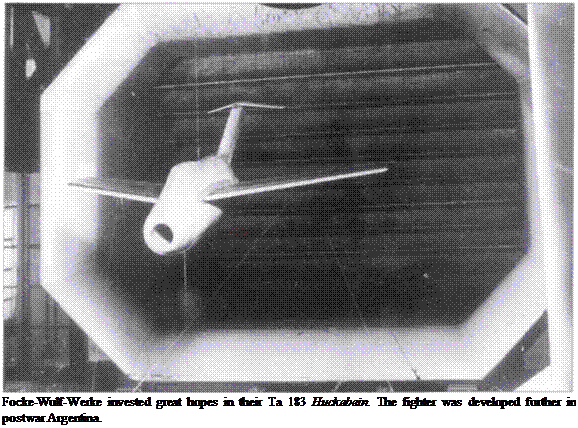Та 183
Compared to the Flitzer, the Та 183 appeared much more suitable for mass production. The design for aTL-Fighter with HeS Oil powerplant (Design 1, Ra-1) presented to the Riistungsstab on 10 January 1945 seemed to increase the chances of Focke-Wulf obtaining the contract for a top-rank fighter. A swept-wing jet with a squat fuselage, designed by engineer Multhopp, it would be armed with either two MK 108s or the more powerful MK 213. The DVT (German Experimental Institute for Aviation) had calculated in January 1945
that the machine would have a top speed of 875 km/hr (544 mph) near the ground and 940 km/hr at 7,000 metres (584 mph at 23,000 ft).
Design 2, Ra-4 from 1945 was to be of steel and wood construction for reasons of economy and to avoid using duraluminum and other high value materials in short supply. In the last version at the beginning of 1945, two large additional fuel tanks were envisaged to increase the range. March 1945 plans have at least two MK 108s with 100 rounds each, but though planning was well advanced nothing had come of this design by the capitulation.

The main effort was concentrated on the Ra-2, a flying mock-up of the future Та 183 with a Jumo 004 turbine. Basic performance calculations and the construction of the fuselage of Та 183 V-l (Ra-2) were completed in March, the second mock-up Та 183 V-2 (Ra-3) would be tested operationally with an HeS 011 powerplant. Work on improved control surfaces, turbine installation and wing fuel tanks was still in hand on 29 March. An increase in armament to four MK 108s, first thought of in Designs 2 and 3 was taken up and the possibility of adding two MK 103s studied. From a typed page dated 18 February
1945 it seems that the development team considered release gear for a 500-kg (1,100-lb) bomb-load. This resulted from the continuing interest of the OKL in machines which could do a stint as fighter-bombers.
In a concluding conference at the EHK (Main Development Commission) on 27 and 28 February 1945 there was unexpected agreement on Focke-Wulf project No. 279 as ‘an immediate solution. RLM number 183 was rejected by the Office for Aircraft Development on technical flight and tactical grounds, the Messer- schmitt ‘optimum solution for tailless construction being favoured. The overall result for the Та 183 was that two prototypes only would be produced in a short series at Detmold. Focke-Wulf wanted ten prototypes and two fuselages (Та 183 M-l to M-12) within four months. The Riistungsstab did not make clear for security reasons whether mass production was likely at the end of it all. Before anything further could be undertaken the Allies overran the factories and all the planning went to waste. On 8 April units of the US 84th Infantry Division occupied Bad Eilsen and district.










